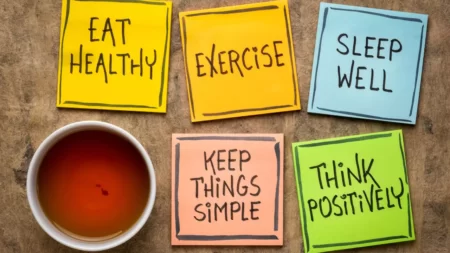If you want to build muscle, you need to follow a well-designed plan that covers all the aspects of muscle growth. Wellhealth’s How To Build Muscle Tag is a comprehensive guide that will help you achieve your goals and unlock your muscular potential.
Understanding Wellhealth Muscle Growth
Muscle growth, or hypertrophy, is the process of increasing the size and strength of your muscle fibers. To stimulate muscle growth, you need to do two things: provide enough nutrition and apply progressive overload.
Importance of Nutrition
The food you eat is what helps your muscles grow. You need to eat enough fats, proteins, carbs, and calories to keep your muscles strong and give you energy. 0.8 to 1.2 grams of protein per pound of body weight, 2 to 3 grams of carbs per pound of body weight, and 0.3 to 0.5 grams of fat per pound of body weight are good amounts to eat. You are free to change these numbers to suit your wants and tastes.
Progressive Overload
Progressive overload means putting your muscles under more and more stress over time. This can be done by doing your workouts more often, with more weight, reps, sets, or intensity. It pushes your muscles to change, which makes them bigger and stronger. Every week or session, you should try to make at least one of these things bigger.
Creating a Wellhealth Structured Workout Plan
A well-structured workout plan is essential for optimal muscle growth. You need to choose the right exercises, balance the volume and intensity, and customize your plan according to your goals and level.
Choosing the Right Exercises
The best exercises for muscle growth are compound movements that work multiple muscle groups at once. These include squats, deadlifts, bench press, rows, pull-ups, dips, and overhead press. You should focus on these exercises and perform them with proper form and technique. You can also add some isolation exercises that target specific muscles, such as curls, extensions, flyes, and lateral raises. These can help you improve your muscle definition and symmetry.
Balancing Volume and Intensity
Volume and intensity are two key factors that determine how much stimulus you provide to your muscles. Volume is the total amount of work you do, measured by the number of sets, reps, and weight. Intensity is how hard you work, measured by the percentage of your one-rep max (1RM) or the rate of perceived exertion (RPE). You need to find the right balance between volume and intensity for your goals and recovery ability. A general guideline is to perform 3 to 6 sets of 6 to 15 reps per exercise, with an intensity of 60% to 85% of your 1RM or an RPE of 6 to 9.
Customizing Your Plan
Your workout plan should be tailored to your specific goals, level, and schedule. You can choose from different types of training splits, such as full-body, upper-lower, push-pull-legs, or body part splits. You can also vary the frequency, duration, and order of your workouts. You should experiment and find what works best for you and your progress.
Wellhealth Rest and Recovery
Rest and recovery are crucial for muscle growth. They allow your muscles to repair, grow, and adapt to the training stimulus. You need to give your muscles enough time and resources to recover between workouts and avoid overtraining.
Role of Rest in Muscle Growth
Rest is the time when your muscles grow the most. During rest, your body produces hormones, such as testosterone and growth hormone, that promote muscle growth. Your muscles also receive nutrients and oxygen from the blood, which help them repair and grow. You should aim to get at least 7 to 9 hours of quality sleep every night and take at least one rest day per week.
Supplements for Muscle Gain
Supplements can help you enhance your muscle growth by providing extra nutrition, energy, or performance. However, supplements are not magic pills and they cannot replace a balanced diet and a solid workout plan. You should only use supplements as an addition to your muscle-building regimen, not as a substitute. Some of the most effective and proven supplements for muscle gain are:
- Creatine: This is a natural chemical that makes your muscles work harder and give you more energy. It can make you stronger, faster, more durable, and gain muscle bulk. It is okay to take 5 grams of creatine monohydrate every day, and it’s best to do it after a workout.
- Protein: Your muscles are made up of protein. It gives you amino acids, which are important for building muscle tissue. A protein drink or bar can help you get more protein and build muscle. You can eat one before or after a workout, or in between meals as a snack.
- BCAAs: Branched-chain amino acids (BCAAs) are three specific amino acids that play a key role in muscle growth and recovery. They are leucine, isoleucine, and valine. You can take BCAAs before, during, or after your workout, or on your rest days, to prevent muscle breakdown and enhance muscle synthesis.
Wellhealth Overcoming Challenges
Building muscle is not an easy task. You will face many challenges along the way, such as plateaus, injuries, and motivation issues. You need to overcome these challenges and keep pushing yourself to achieve your muscular potential.
Plateaus and How to Break Them
A plateau is a point where your progress stalls and you stop seeing results. This can happen for various reasons, such as adaptation, boredom, or fatigue. To break a plateau, you need to change something in your training or nutrition. You can try the following strategies:
- Increase or decrease your volume or intensity
- Change your exercises, reps, sets, or rest periods
- Use different equipment, such as dumbbells, barbells, cables, or machines
- Incorporate advanced techniques, such as drop sets, supersets, or rest-pause sets
- Adjust your calories, protein, carbs, or fats
- Cycle your supplements, such as creatine, caffeine, or beta-alanine
Injury Prevention
Injuries are the worst enemy of muscle growth. They can set you back for weeks or months, or even end your muscle-building journey. To prevent injuries, you need to follow these tips:
- Warm up properly before every workout
- Use correct form and technique for every exercise
- Avoid lifting too heavy or too fast
- Listen to your body and stop when you feel pain or discomfort
- Stretch and foam roll after every workout
- Rest and recover adequately between workouts
Staying Motivated
Motivation is the fuel that drives you to work hard and achieve your goals. However, motivation can fluctuate and fade over time. To stay motivated, you need to do the following:
- Set achievable objectives and track your progress.
- Celebrate your achievements and reward yourself
- Find a workout partner or a coach who can support you and hold you accountable
- Join a community or a group of like-minded people who share your passion and vision
- Remind yourself of your reasons and benefits of building muscle
- Visualize your desired outcome and how it will make you feel
Safety Precautions
Building muscle is a rewarding and enjoyable activity, but it also involves some risks and responsibilities. You need to be aware of the potential dangers and take the necessary precautions to ensure your safety and health. You should follow these guidelines:
- Consult your doctor before starting any exercise or nutrition program, especially if you have any medical conditions or injuries
- Do not use any illegal or banned substances, such as steroids, hormones, or stimulants, that can harm your body and health
- Do not follow any extreme or fad diets, such as very low-calorie, very high-protein, or very low-carb diets, that can cause nutrient deficiencies, metabolic damage, or organ failure
- Do not overtrain or undertrain, as both can lead to poor performance, muscle loss, or health problems
- Do not neglect other aspects of your life, such as your family, friends, work, or hobbies, that can enrich your happiness and well-being





